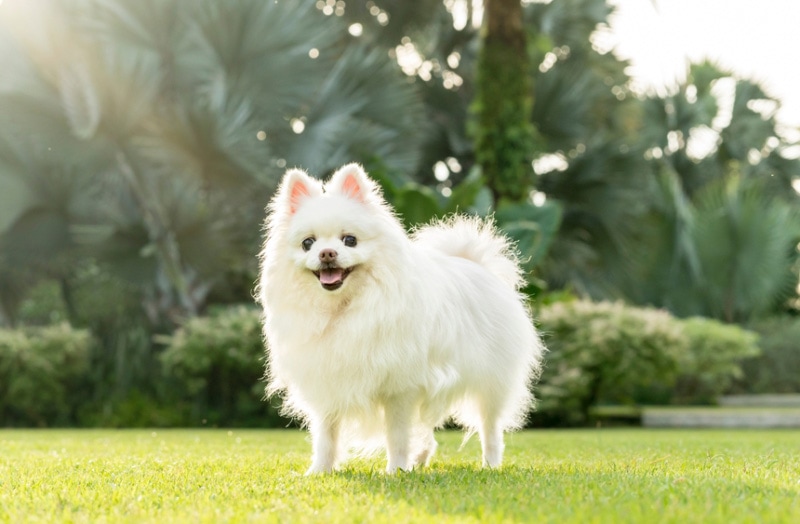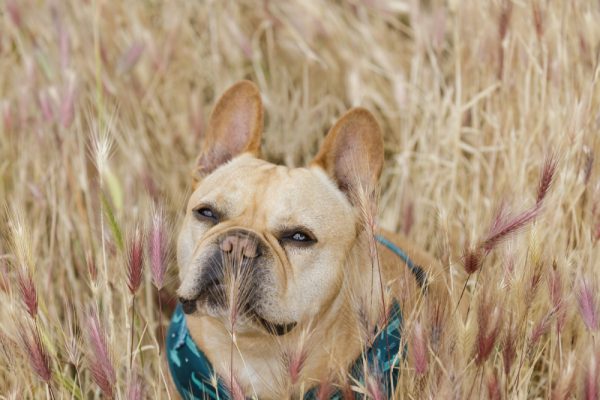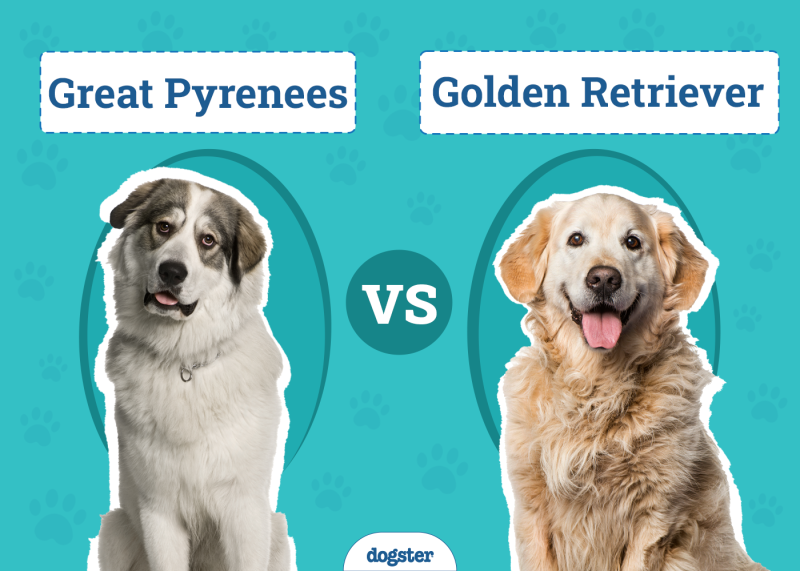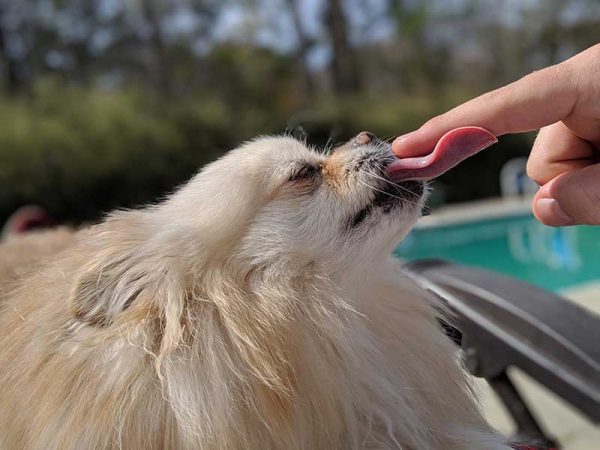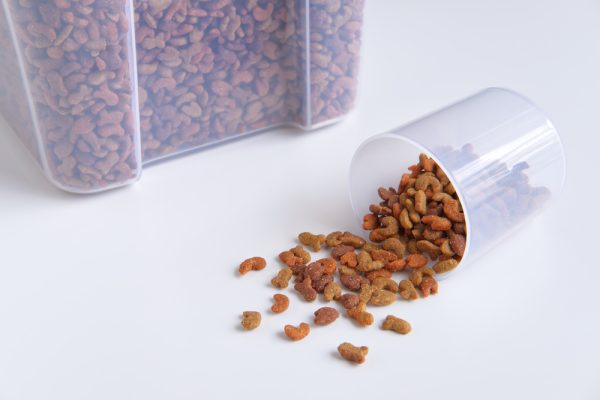There are several small white dog breeds, and due to their charming appearance, friendly demeanor, and ability to fit into various lifestyles, they are often popular pets. While they may share certain physical traits, each one is special due to their unique qualities.
So, whether you want to learn more about small white dogs or have your heart set on bringing one home, we have you covered. In this article, we will cover a variety of small white dog breeds with their distinctive characteristics and rich history.

How Are Small White Dogs Classified?
Dogs that weigh 21 pounds or less are considered small breeds. They’re an excellent choice if you live in an apartment or small house because they often require less space to be comfortable and happy. Additionally, small dogs typically eat less and require less basic care than large-breed dogs. They shed less than larger dogs and are also easier to handle when carried or walked.
If you don’t have a backyard for them to play in, a dog park or walking route is a great way to help them get their exercise. Generally, small dogs live longer and are more resilient than larger breeds. However, despite the advantages, small dogs have several drawbacks.
Although they are usually healthy, their small size makes them more vulnerable to injury, particularly if they are dropped, handled aggressively, or fall from high furniture. White dogs may need more upkeep when groomed than other, darker-colored dogs because dirt and stains aren’t as easily hidden on white coats. Additionally, tear stains can be challenging to remove and are more common in white dogs.
The 14 Small White Dog Breeds
1. Maltese
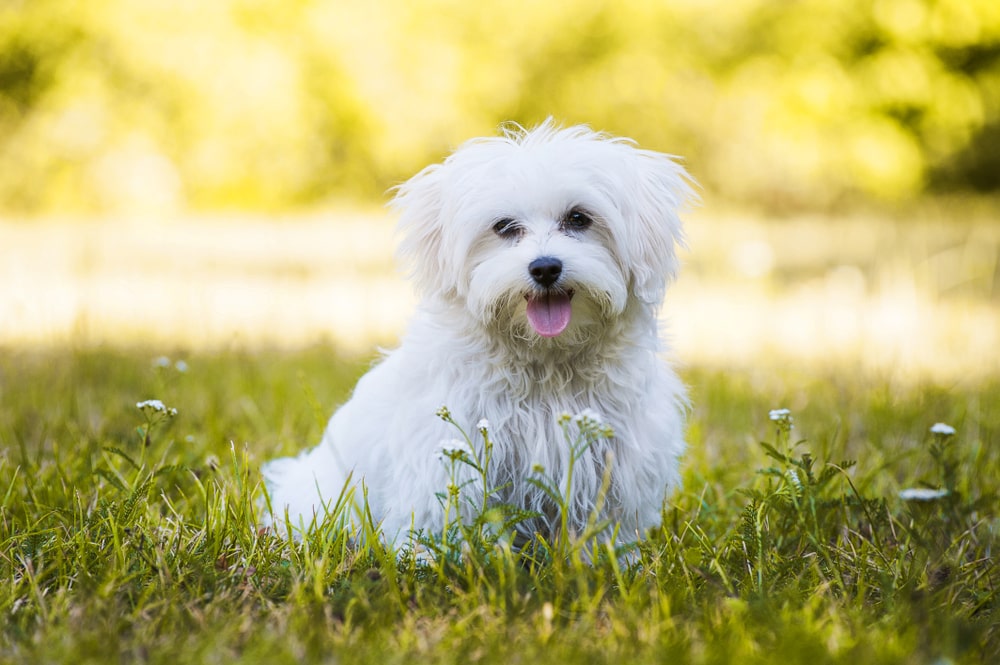
| Origin: | Malta |
| Height: | 7–9 inches |
| Weight: | Under 7 pounds |
| Lifespan: | 12–15 years |
The Maltese is often the first dog to come to mind when you think of a small white dog. Their white, floor-length coat is their distinguishing feature. The Maltese is an intelligent, affectionate, charming, and playful companion that makes a wonderful family dog. They are also alert and fearless, which makes them great watchdogs. They are adaptable dogs that can happily live indoors, and although they can be stubborn at times, they respond well to positive reinforcement. Maltese are low shedders and suitable as pets for most allergy sufferers. However, they can be challenging to housebreak and have picky eating habits.
Maltese dogs have existed for at least 29 centuries; however, their exact origin is still debatable. The Maltese are thought to have come from Malta, a small island south of Sicily, and were bred for companionship, a job they still excel at today. Historians believe that trade allowed the Maltese to spread to other parts. The Maltese finally arrived in America in the 1800s, and the American Kennel Club (AKC) approved the breed in 1888.
2. Pomeranian
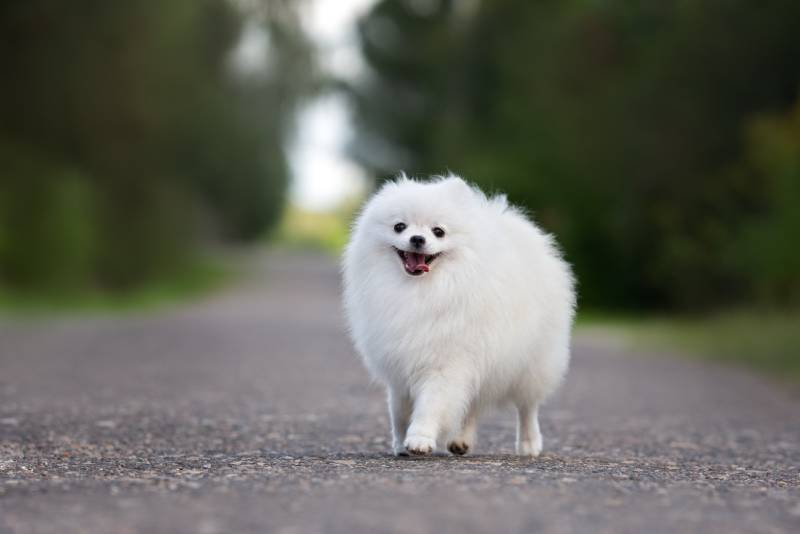
| Origin: | Germany and Poland |
| Height: | 6–7 inches |
| Weight: | 3–7 pounds |
| Lifespan: | 12–16 years |
The plush Pomeranian is one of the world’s most popular toy breeds. Their abundant coats come in various colors. Pomeranians have a vivacious personality and are intelligent and easily trained. They make fine watchdogs and are often used as therapy dogs. Poms are content in apartments and may be exercised with indoor play and short walks. They get along with other pets, kids, and the elderly and love attention.
Pomerania, a region on the Baltic Sea in Poland and Germany, is where Pomeranians got their name. They evolved into the modern-day breed that is recognized today. Pomeranians are miniature relatives of the Spitz sled dogs.
They were utilized for herding when they were much bigger, weighing around 30 pounds. They were bred to decrease in size to what we now recognize after they became popular with Queen Victoria.
3. Bichon Frise
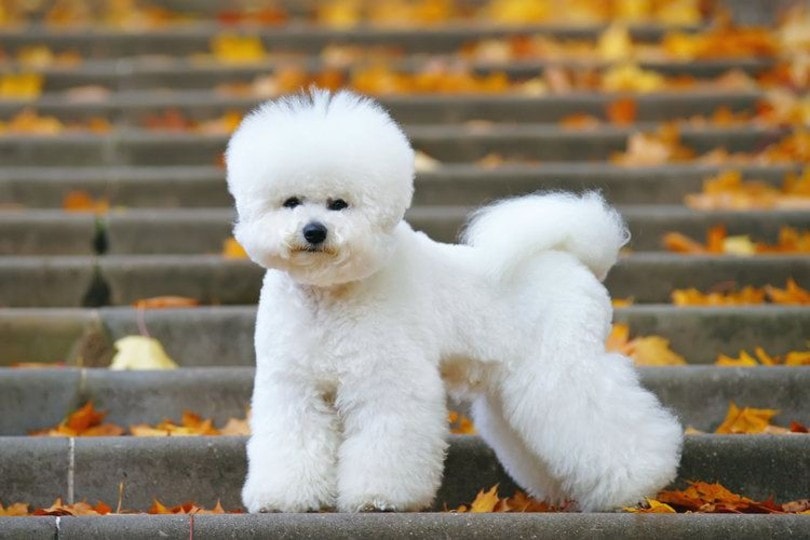
| Origin: | Canary Islands |
| Height: | 9.5–11.5 inches |
| Weight: | 12–18 pounds |
| Lifespan: | 14–15 years |
The Bichon Frise is often mistaken for white Poodles due to their plush and soft white coat, round head, and dark eyes. They are excellent city dogs because of their confidence and size, and even inexperienced pet parents and apartment owners can keep them happy. They are incredibly intelligent and playful and get along with kids and other dogs. They are alert and inquisitive and make cute little watchdogs.
The Bichon Frise is believed to have originated in Italy and was brought there by traders who traveled along the Phoenician trade route. Other historians contend that the breed was brought to Tenerife by Spanish sailors and that Italian sailors returned the animals to Europe in the 14th century.
By the 19th century, they were less popular. Some of them were used in circus troupes, while others were street dogs. After World War I, their popularity began to grow again. In 1956, a French family named Picault introduced the breed to the country for the first time. The American Kennel Club designated the Bichon Frise as a non-sporting dog in 1973.
4. Coton De Tulear
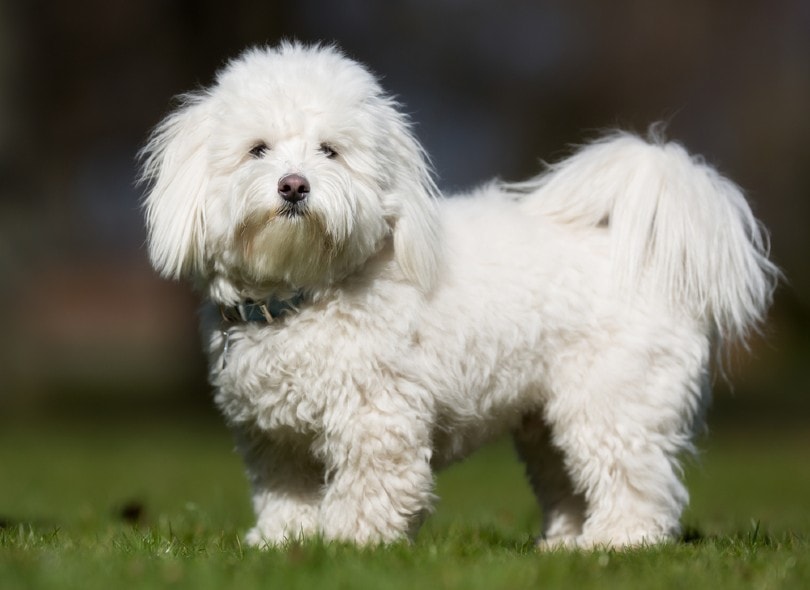
| Origin: | Madagascar |
| Height: | 9–11 inches |
| Weight: | 8–15 pounds |
| Lifespan: | 15–19 years |
The Coton de Tulear is also known for their soft white coat, hence their name, and is loved for their ability to form such tight bonds with its humans. They are often described as gentle dogs with a sympathetic awareness that are naturally entertaining and carefree. The Coton de Tulear is an adaptable and cheerful breed that thrives in most environments. They enjoy running around in the yard but don’t require vigorous exercise to be content. They love their humans and thrive in households where they aren’t left alone for extended periods.
The Coton de Tulear’s past is a little cloudy, but it’s believed that they came to the port city of Toliara in Madagascar in the 15th century and were crossed with wild dogs. The Coton de Tulear was a rare breed that became a must-have pet for the royals on the island when France colonized Madagascar in the 1700s. Since others were not allowed to own one, the breed became known as the “Royal Dog of Madagascar.”
5. Bolognese
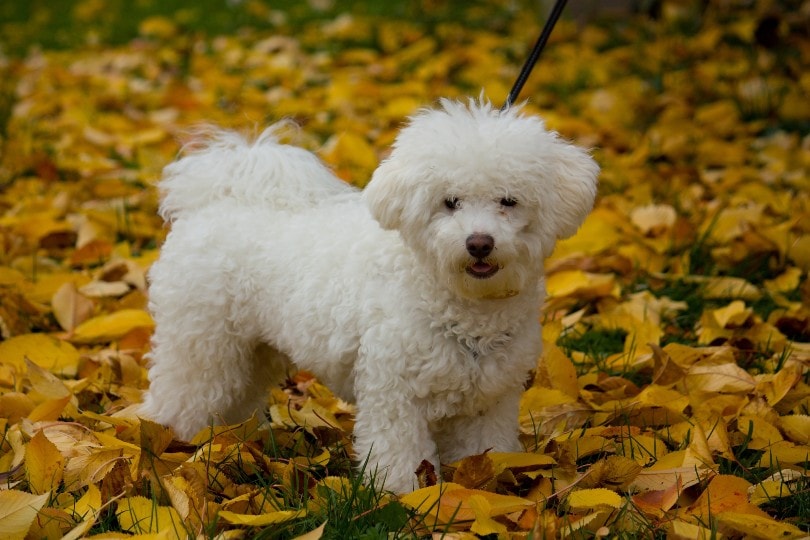
| Origin: | Italy |
| Height: | 10–12 inches |
| Weight: | 6–10 pounds |
| Lifespan: | 12–14 years |
Bolognese dogs were raised as companion animals and are happiest with their owners, whether out for a stroll or cuddling on the couch. They are calm, witty, intelligent, and devoted. They have a lot of personality for such a small breed, and they adapt well to apartment living. The Bolognese is a friendly canine that gets along with other household pets and kids. They don’t have heaps of energy and are generally wary of strangers. However, they can quickly warm up to strangers if they are well-socialized.
Despite being an uncommon breed, Bolognese dogs have been around for more than 2,000 years. Bolognese puppies were given as gifts by the Italian nobility to one another throughout the Renaissance, and the little dogs were regarded as a sign of prosperity. Despite the love for the breed, the decline of European aristocracies nearly led to the extinction of the Bolognese. However, several breed lovers preserved the dogs from extinction, and in 1999, the breed was approved into the American Kennel Club’s Foundation Stock Service.
6. Havanese
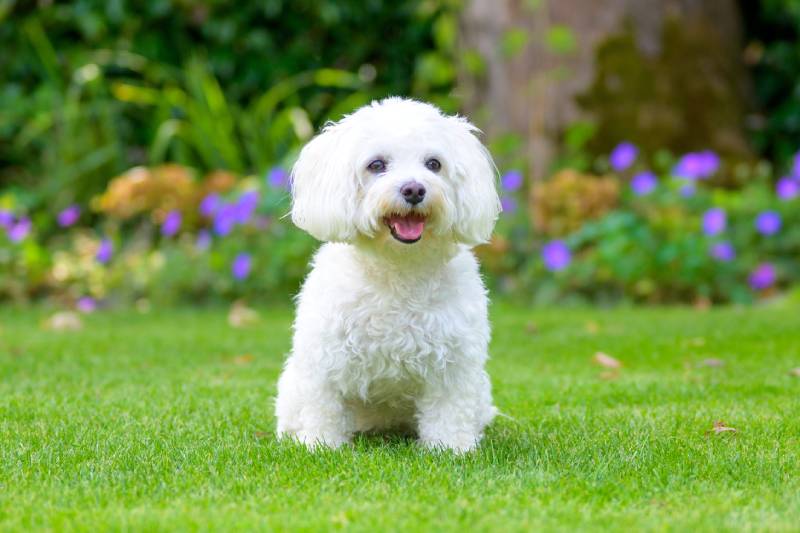
| Origin: | Cuba |
| Height: | 8.5–11.5 inches |
| Weight: | 7–13 pounds |
| Lifespan: | 14–16 years |
The Havanese are intelligent, lively, and very trainable. These energetic and gregarious companions are growing in popularity, especially among American city people, but they are happy to be anywhere as long as they have attention. Havanese are good watchdogs and take their role seriously. They are not highly active, but daily walks and a bit of playtime will keep them happy. When trained, socialized, and watched closely from a young age, they are incredibly friendly and typically well-behaved with humans and other dogs.
The Havanese is the only dog native to Cuba. Tenerife dogs were first transported to Cuba in the early 1500s by Spanish farmers and aristocrats. With little to no outside influences, these dogs evolved into the Havanese. The breed was adopted as a family pet in Havana. The Havanese was found by European travelers visiting Havana in the 18th century.
The small dog swiftly won over the nobles of Spain, France, and Great Britain. Some Cubans escaped to the United States during the Cuban Revolution in the 1950s, taking the tiny pups with them. These dogs served as the precursors of today’s modern Havanese breed.
7. Miniature American Eskimo
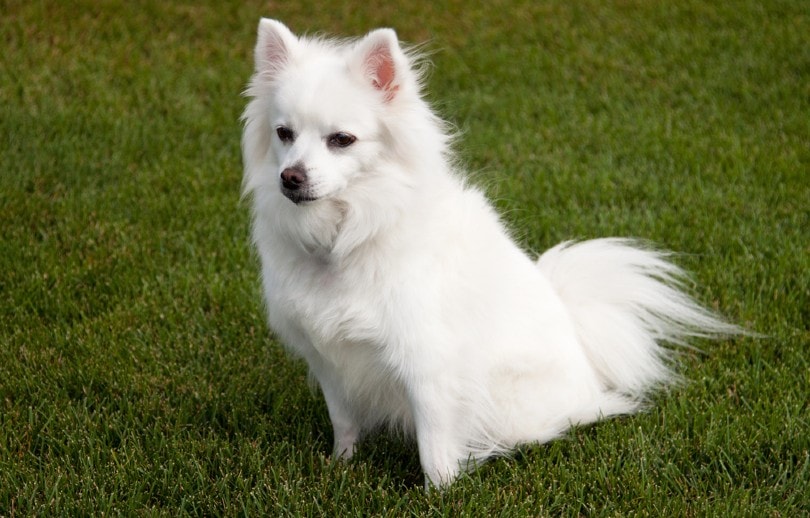
| Origin: | Germany |
| Height: | 12–15 inches |
| Weight: | 10–20 pounds |
| Lifespan: | 13–15 years |
The American Eskimo, affectionately known as the Eskie, is a family dog that requires constant interaction with their owners. One of their distinguishing features is a dense, shining white coat with a lion-like ruff across the chest and shoulders. Eskies are constantly alert and sociable, though they might be a little reserved when making new friends. The intelligent, child-friendly Eskie is one of the most trainable breeds and almost coined the term “eager to please.” They are good watchdogs but may have a tendency to bark too much.
American Eskimos first arrived in the United States in the 19th century. They frequently accompanied German immigrants and were likely offspring of the white Pomeranian, white Italian Spitz, and white Keeshond. The name “American Spitz” was quickly given to these dogs. They were popular in circuses and other forms of entertainment in the late 19th and early 20th centuries, where they quickly grew in popularity.
8. Japanese Spitz
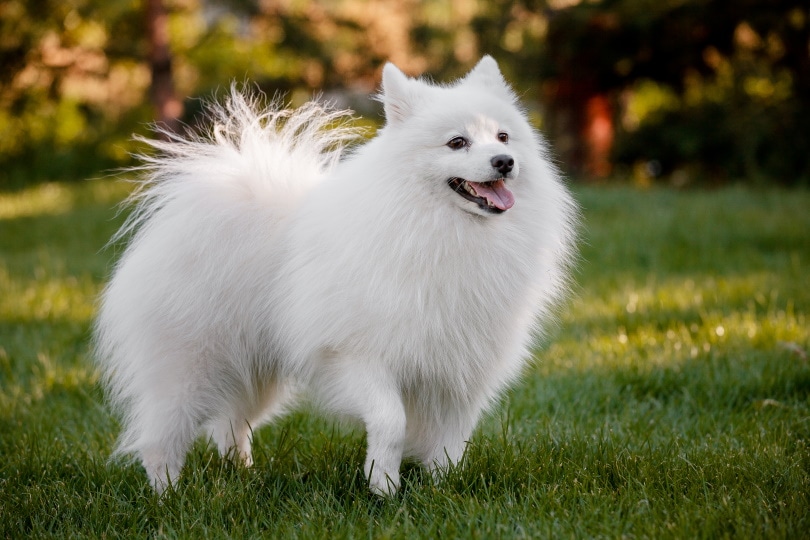
| Origin: | Japan |
| Height: | 12–15 inches |
| Weight: | 10–25 pounds |
| Lifespan: | 10–14 years |
The Japanese Spitz is a small dog with the courage of an enormous watchdog. They are adorable comedians who love to go on adventures and have an unwavering love for their humans. They are loyal and intelligent and want to make their owners happy. They get along well with kids and make excellent apartment dogs as long as their exercise requirements are met. Despite having stunning white fur, they are low maintenance and only require minimal grooming.
Two white Spitzes were brought from Canada in 1925, and the first Japanese Spitz exhibit occurred in 1921 in Tokyo. The Japanese Spitz was not officially recognized by the Japan Kennel Club until after World War II when the breed’s requirements were finalized.
9. West Highland White Terrier
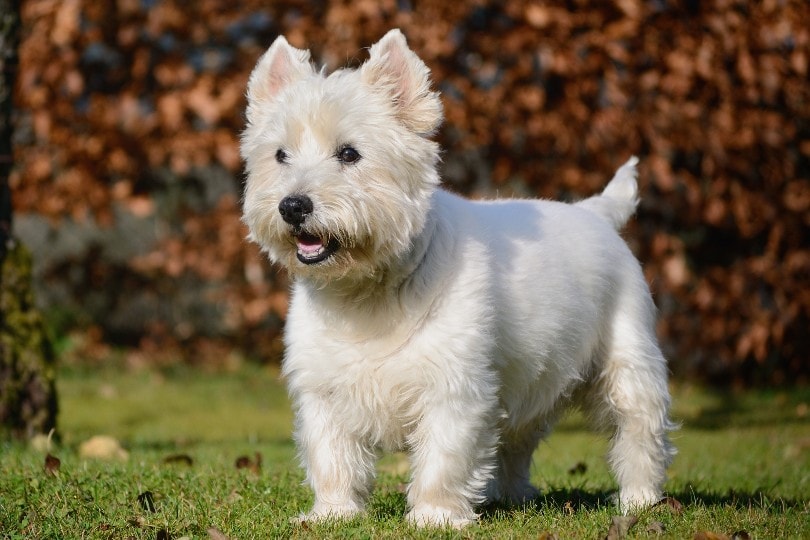
| Origin: | Scotland |
| Height: | 10–11 inches |
| Weight: | 15–20 pounds |
| Lifespan: | 13–15 years |
Owners have been won over by the charming West Highland White Terrier, or Westie, for over 300 years, and they are one of the most popular small terriers. Despite not being soft and fluffy to the touch, the all-white double coat made it easier for their guardians to spot them in the fields and tell them apart from the game they were hunting. They are intelligent, confident, and charming when they play. They don’t need to be coddled, but they may chase after anything that moves, and training them can be difficult because of their independence. Westies can be hazardous around small pets like bunnies and are not always good with dogs they have not grown up with.
The small white Westies were referred to as dogs of Argyleshire as early as the 1600s. Colonel Malcom of Poltalloch originated the breed’s type in the 1800s, and the West Highland white terrier was first known as the Poltalloch for a period and subsequently as the Roseneath terrier after the colonel’s farm. Like other Terrier breeds, the West Highland was developed as a rodent hunter.
10. Toy Poodle
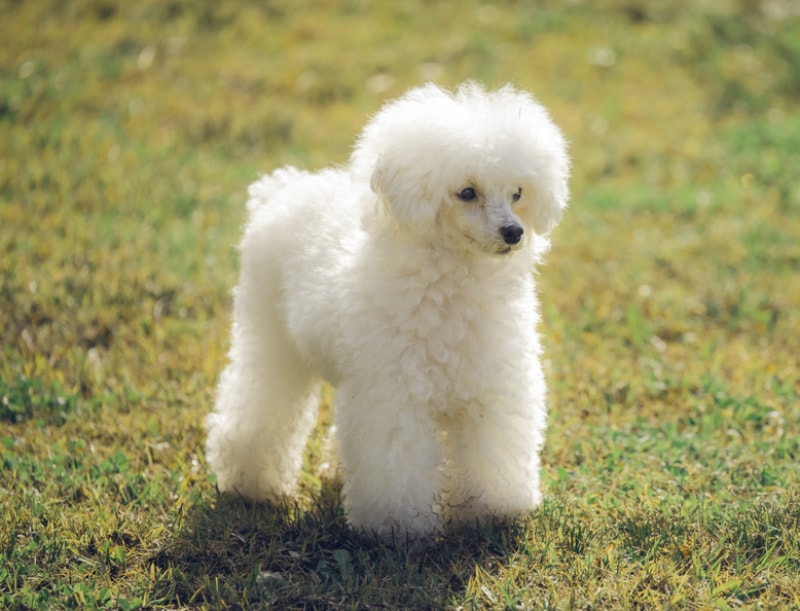
| Origin: | Germany |
| Height: | Up to 10 inches |
| Weight: | 4–6 pounds |
| Lifespan: | 10–18 years |
The Toy Poodle is One of the most intelligent and entertaining dog breeds. In addition to being adorable, Toy Poodles make excellent family dogs. They are incredibly intelligent, athletic, and eager to please, making them simple to train. Toy Poodles don’t shed much, making them a good choice for allergy sufferers. Although all interactions between dogs and children should be under adult supervision, the Toy Poodle is friendly towards children and other animals.
The Poodle originated as a duck hunter in Germany, despite their association with France. The Toy Poodle was bred down from a miniature and was initially developed in America in the early 20th century as a companion dog for people living in the city.
11. Chinese Crested
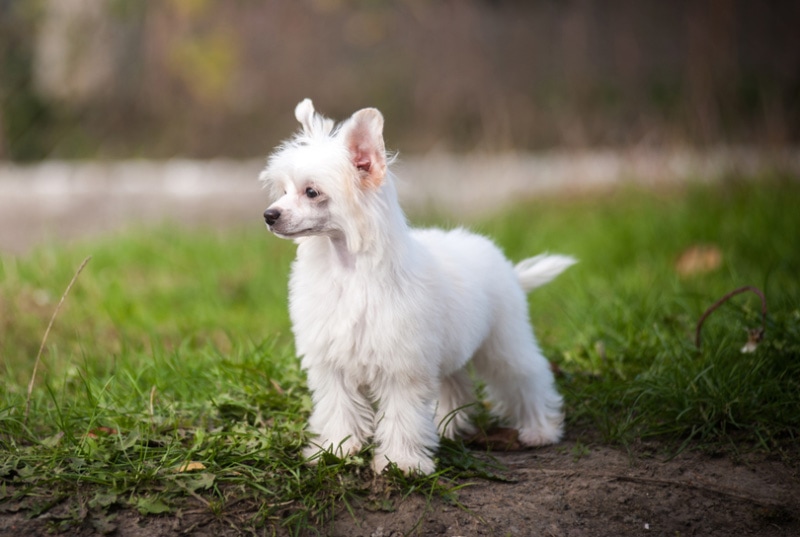
| Origin: | Mexico |
| Height: | 11–13 inches |
| Weight: | 8–12 pounds |
| Lifespan: | 13–18 years |
The Chinese Crested is an energetic, alert toy breed that can have fur or be hairless. They are loving, playful, loyal, and cheerful and fit in with most families, including those with other pets and children. However, the dogs are small and somewhat fragile, so all interactions with kids should be supervised. This breed is also suitable for seniors or people who reside in small apartments.
They require only minimal activity to remain healthy, and they often like playing inside or lying back on the sofa alongside their owner. There is no evidence to support the theory that Chinese crested came from China; a study points to Mexico as their possible origin. Nonetheless, the Chinese Crested has been bred to be a loving companion for ages. In the United States, the Chinese crested briefly gained favor in the late 1800s and early 1900s before regaining it in the 1970s. Gipsy Rose Lee was the most well-known advocate for the breed. The AKC granted recognition in 1991.
12. Lhasa Apso
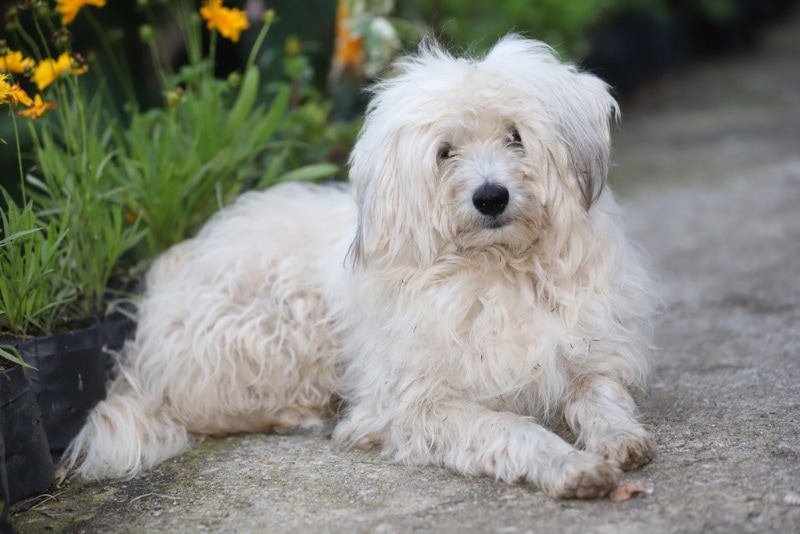
| Origin: | Tibet |
| Height: | 9–11 inches |
| Weight: | 12–18 pounds |
| Lifespan: | 12–15 years |
The Lhasa Apso is renowned for its long, flat-hanging coat with a center parting that causes it to drape on each side of the body. They are intelligent, confident, lively, and a little silly. These dogs are loving with individuals they know and trust but can be reserved with strangers. They should be socialized with people, other animals, and dogs from the time they are puppies because they are not usually good with other dogs. Training is essential for Lhasa Apsos because, despite their intelligence, they can be a little independent and stubborn.
The Lhasa Apso is native to Tibet. Due to their alert temperament and loud bark, Lhasa Apsos were used as guard dogs in addition to being pets. The Lhasa Apso became a breed after Tibet adopted Buddhism in the 7th century AD. Lhasa Apsos were kept by the Dalai Lamas as pets and as gifts for distinguished visitors.
13. French Bulldog
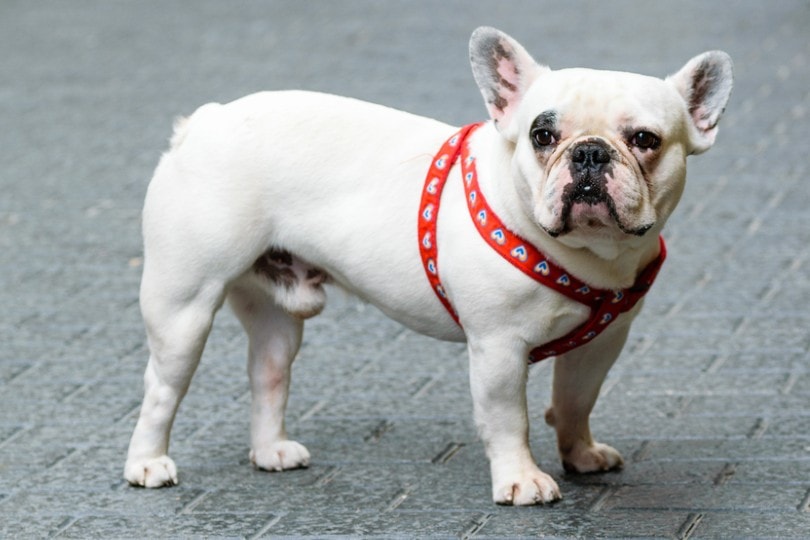
| Origin: | France |
| Height: | 11–13 inches |
| Weight: | Under 28 pounds |
| Lifespan: | 10–12 years |
The French Bulldog is one of the world’s most popular little dog breeds, especially among city people. The lively, attentive, versatile, appealing Frenchie is distinguished by their large bat-like ears and miniature Bulldog appearance. They are content living alone, in pairs, or with families and don’t need much outdoor activity.
They get along nicely with other animals and love meeting new human friends. Frenchies are quiet dogs who rarely bark, yet their attentiveness makes them good watchdogs. They are low maintenance when it comes to grooming and exercise and prefer to be at home with their owner and be the center of attention.
Early in the 19th century, English lacemakers traveled to France for employment. Smaller Bulldogs were brought along to be companion animals and chase away rodents on the farms. They quickly grew in popularity and became a companion for royalty and the upper class.
14. Puli
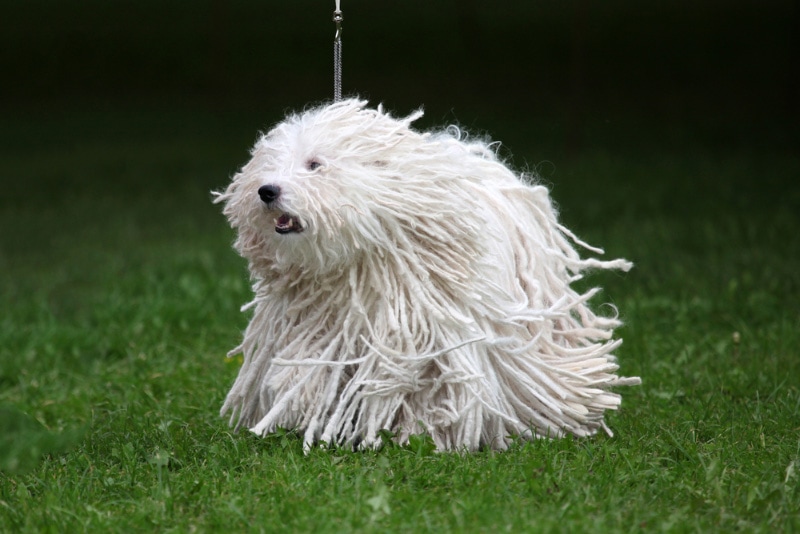
| Origin: | Hungary |
| Height: | 16–17 inches |
| Weight: | 25–35 pounds |
| Lifespan: | 10–15 years |
You can’t mistake the Puli for any other dog due to their distinct dreadlock-like coat. This energetic, perceptive, confident, and clever dog has a strong sense of loyalty to their loved ones. The Puli is a highly intelligent dog with a great sense of humor. They are superb watchdogs but do not typically bark excessively. The Puli makes a wonderful family companion if properly trained and given daily exercise.
It’s believed that Pulis was brought to Europe by the Magyars approximately 1,000 years ago. They were bred to herd sheep, and their corded coats shielded them from the harsh winters.

Conclusion
Small white dogs are undeniably cute, but as you can tell, they have a lot more to offer. They are generally easy to travel with, can adapt to apartment living, and are often suitable for all types of families. However, they are still little balls of energy and need exercise, training, and socialization just like any other dog breed, as well as a quality diet, health care, and lots of love that will undoubtedly be returned.
Featured Image Credit: Tam and Trace Photography, Shutterstock
